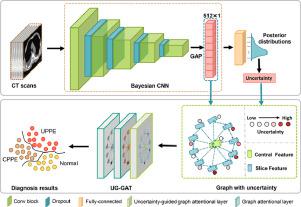Medical Image Analysis ( IF 10.7 ) Pub Date : 2021-11-03 , DOI: 10.1016/j.media.2021.102217 Jinkui Hao 1 , Jiang Liu 2 , Ella Pereira 3 , Ri Liu 4 , Jiong Zhang 5 , Yangfan Zhang 4 , Kun Yan 4 , Yan Gong 6 , Jianjun Zheng 4 , Jingfeng Zhang 4 , Yonghuai Liu 3 , Yitian Zhao 7

|
Parapneumonic effusion (PPE) is a common condition that causes death in patients hospitalized with pneumonia. Rapid distinction of complicated PPE (CPPE) from uncomplicated PPE (UPPE) in Computed Tomography (CT) scans is of great importance for the management and medical treatment of PPE. However, UPPE and CPPE display similar appearances in CT scans, and it is challenging to distinguish CPPE from UPPE via a single 2D CT image, whether attempted by a human expert, or by any of the existing disease classification approaches. 3D convolutional neural networks (CNNs) can utilize the entire 3D volume for classification: however, they typically suffer from the intrinsic defect of over-fitting. Therefore, it is important to develop a method that not only overcomes the heavy memory and computational requirements of 3D CNNs, but also leverages the 3D information. In this paper, we propose an uncertainty-guided graph attention network (UG-GAT) that can automatically extract and integrate information from all CT slices in a 3D volume for classification into UPPE, CPPE, and normal control cases. Specifically, we frame the distinction of different cases as a graph classification problem. Each individual is represented as a directed graph with a topological structure, where vertices represent the image features of slices, and edges encode the spatial relationship between them. To estimate the contribution of each slice, we first extract the slice representations with uncertainty, using a Bayesian CNN: we then make use of the uncertainty information to weight each slice during the graph prediction phase in order to enable more reliable decision-making. We construct a dataset consisting of 302 chest CT volumetric data from different subjects (99 UPPE, 99 CPPE and 104 normal control cases) in this study, and to the best of our knowledge, this is the first attempt to classify UPPE, CPPE and normal cases using a deep learning method. Extensive experiments show that our approach is lightweight in demands, and outperforms accepted state-of-the-art methods by a large margin. Code is available at https://github.com/iMED-Lab/UG-GAT.
中文翻译:

用于肺炎旁积液诊断的不确定性引导图注意网络
肺炎旁胸腔积液 (PPE) 是一种常见的疾病,会导致肺炎住院患者死亡。在计算机断层扫描 (CT) 扫描中快速区分复杂 PPE (CPPE) 和简单 PPE (UPPE) 对于 PPE 的管理和医疗具有重要意义。然而,UPPE 和 CPPE 在 CT 扫描中显示出相似的外观,并且无论是由人类专家尝试,还是通过任何现有的疾病分类方法,都很难通过单个 2D CT 图像区分 CPPE 和 UPPE。3D 卷积神经网络 (CNN) 可以利用整个 3D 体积进行分类:但是,它们通常存在过拟合的内在缺陷。因此,开发一种不仅可以克服 3D CNN 的大量内存和计算要求的方法非常重要,而且还利用了 3D 信息。在本文中,我们提出了一种不确定性引导的图注意力网络(UG-GAT),它可以自动从 3D 体积中的所有 CT 切片中提取和整合信息,以分类为 UPPE、CPPE 和正常控制案例。具体来说,我们将不同案例的区别描述为一个图分类问题。每个个体都表示为具有拓扑结构的有向图,其中顶点表示切片的图像特征,边缘编码它们之间的空间关系。为了估计每个切片的贡献,我们首先使用贝叶斯 CNN 提取具有不确定性的切片表示:然后我们利用不确定性信息在图预测阶段对每个切片进行加权,以便做出更可靠的决策。在本研究中,我们构建了一个由来自不同受试者(99 例 UPPE、99 例 CPPE 和 104 例正常对照病例)的 302 个胸部 CT 体积数据组成的数据集,据我们所知,这是对 UPPE、CPPE 和正常进行分类的首次尝试使用深度学习方法的案例。大量实验表明,我们的方法在需求上是轻量级的,并且在很大程度上优于公认的最先进的方法。代码可在 https://github.com/iMED-Lab/UG-GAT 获得。并且大大优于公认的最先进的方法。代码可在 https://github.com/iMED-Lab/UG-GAT 获得。并且大大优于公认的最先进的方法。代码可在 https://github.com/iMED-Lab/UG-GAT 获得。











































 京公网安备 11010802027423号
京公网安备 11010802027423号